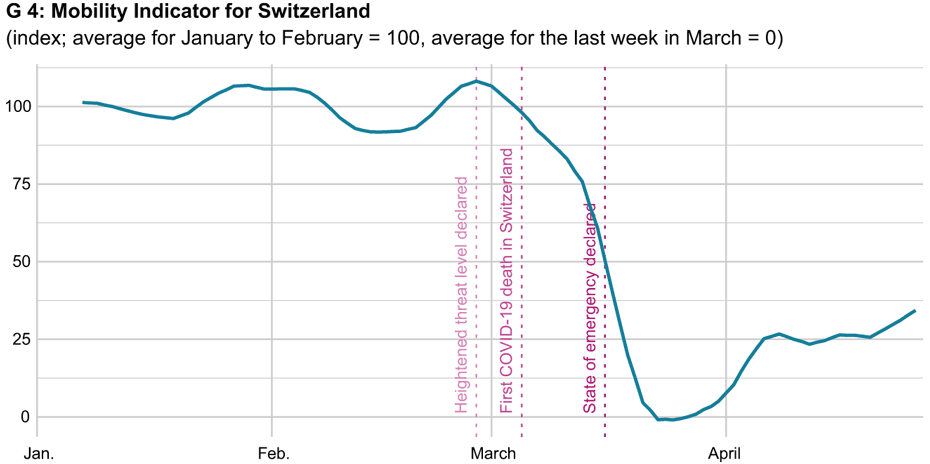A mobility indicator for Switzerland
- KOF Bulletin
- Indicators
The measures taken to slow the spread of the COVID-19 pandemic also aim to reduce social interaction. What influence do these measures have on the mobility behaviour of the Swiss? KOF researchers have developed an indicator that constantly shows this. According to the indicator, mobility has continued to increase in recent days, having reached its lowest level at the end of March. However, it is still far from its normal state.

Entry restrictions, school and business closures, bans on events, and social distancing all have a drastic effect on whether and how the population moves in public spaces. The mobility indicator shows the fundamental trends of selected daily time series that reflect the mobility behaviour of the Swiss population.
These include the volume of private transport, the use of public transport, cash withdrawals, debit card use, flight movements and the use of online platforms. Various time series at daily frequency are collected and made publicly available by the Social Monitoring unit at the Statistical Office of the Canton of Zurich . KOF also prepares a wide range of high-frequency indicators, forecasts and survey results and offers them in machine-readable formats. If necessary, missing values are interpolated and the data are adjusted for weekly seasonality.
The indicator shows a significant decline in the mobility of the Swiss population – even before the Federal Council declared a state of emergency on 16 March (Chart 4). Mobility reached its lowest level at the end of March. Thereafter there was an increase, which not surprisingly flattened out somewhat after Easter. Most recently, the mobility indicator has been trending slightly upwards again. Restrictions on the retail and services sectors were eased slightly on 28 April. For example, DIY stores, garden centres and hairdressing salons are now allowed to reopen and non-urgent medical interventions are allowed. Public and private events are still prohibited, and entertainment and leisure facilities must also remain closed.
As far as the mobility indicator is concerned, this should mean that the trend towards normalisation in the mobility behaviour of the Swiss population will probably continue. However, we are still a long way from returning to the normal values of January and February.
Further information on the mobility indicator can be found here.
Contact
KOF Konjunkturforschungsstelle
Leonhardstrasse 21
8092
Zürich
Switzerland
Contact
KOF Konjunkturforschungsstelle
Leonhardstrasse 21
8092
Zürich
Switzerland

